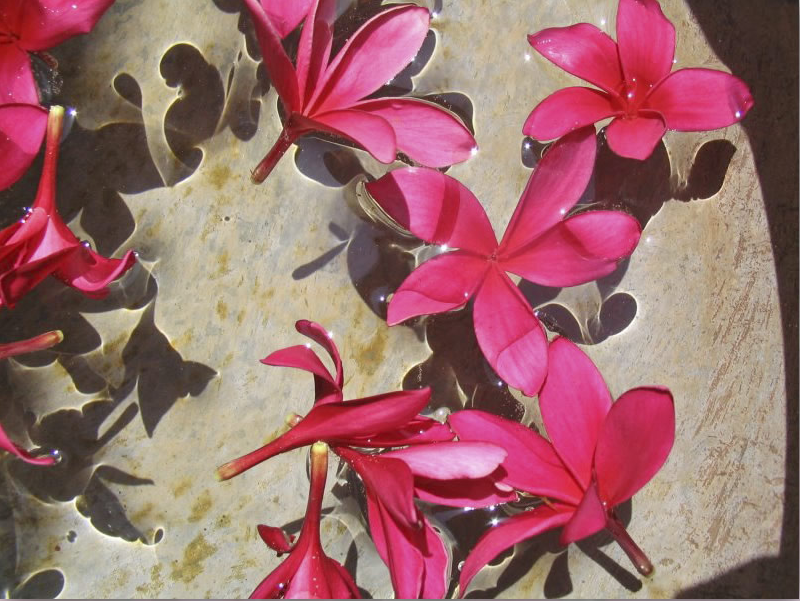Caustic petals
Caustic Petals: Unveiling the Optical Wonders of Nature
Nature never ceases to amaze us with its mesmerizing phenomena, and one such captivating spectacle is the caustic petals. These enchanting patterns, reminiscent of delicate flower petals, are formed when the elastic surface of water is distorted by plumarias, creating brilliant caustic curves beneath. As we delve into the intricate workings of this optical phenomenon, we uncover the hidden secrets that make caustic petals a breathtaking sight to behold.
At the heart of caustic petals lies the fascinating concept of surface tension. Just as some small insects gracefully traverse across the water's surface, flowers too find their support in the web of surface tension forces. When a flower makes contact with the water, it creates a meniscus—a curved surface where the water clings to the flower. This meniscus stretches into strong curves that protrude towards the air, driven by the surface's inherent tendency to minimize energy and area.
The curved meniscus of the water's surface acts as a lens, refracting the incoming sunlight. Within this interplay of light and water, a magical phenomenon occurs. At specific points along the meniscus, numerous refracted rays converge and bundle together, resulting in the formation of bright lines on the water's surface known as caustics. These caustics elegantly trace the contours of the flower, casting intricate patterns that resemble delicate petals.
While menisci play a crucial role in creating caustic petals, they are not the only medium through which this phenomenon manifests. Even waves rippling across a body of water can bend sunlight, giving rise to dancing caustic patterns at the bottom of swimming pools or on shallow sea beds. This captivating display demonstrates how light interacts with various elements in nature, bringing forth stunning visual displays that often go unnoticed.
Caustic petals are not alone in their ethereal beauty. Another awe-inspiring caustic phenomenon that we encounter in our daily lives is the rainbow. Rainbows, too, are formed by the bending and dispersion of sunlight as it interacts with water droplets suspended in the air. The intricate dance of refraction and reflection within raindrops creates the vibrant arcs of colors that grace our skies after a rain shower. Like caustic petals, rainbows serve as a reminder of the hidden wonders that can be found in the simplest of natural phenomena.
In conclusion, caustic petals offer us a glimpse into the harmonious interplay between light and water. As flowers delicately rest upon the water's surface, they give rise to mesmerizing caustic curves that mirror the elegance of petals. Through the lens of surface tension and refraction, we can witness the enchanting dance of light and water, unveiling the intricate patterns that nature effortlessly weaves. So, the next time you encounter caustic petals or a rainbow, take a moment to appreciate the captivating optical wonders that surround us and remind us of the beauty that lies within the natural world.

Petal Caustics
Plumarias distort the elastic water surface to generate bright caustic curves beneath. Imaged by Manoj Saranathan of Rochester, Minnesota. ©Manoj Saranathan, shown with permission.

The flowers are supported by surface tension forces just as some small insects 'walk' on water. At points of contact the surface forms a meniscus. It stretches into strong curves convex towards the air. The tendency for the surface to return to a minimum energy and area - a planar shape in this case - provides the force to support the flower.
The curved meniscus refracts the incoming sunlight. There are regions - turning points - where many refracted rays bundle together with similar deflections and these result in bright lines on the bowl surface called caustics.
A meniscus is not always necessary. Waves on water also deflect sunlight resulting in the dancing caustic patterns at the base of a swimming pool or on a shallow sea bed.
Rainbows are another caustic phenomenon.
Note: this article has been automatically converted from the old site and may not appear as intended. You can find the original article here.
Reference Atmospheric Optics
If you use any of the definitions, information, or data presented on Atmospheric Optics, please copy the link or reference below to properly credit us as the reference source. Thank you!
-
<a href="https://atoptics.co.uk/blog/caustic-petals/">Caustic petals</a>
-
"Caustic petals". Atmospheric Optics. Accessed on November 26, 2024. https://atoptics.co.uk/blog/caustic-petals/.
-
"Caustic petals". Atmospheric Optics, https://atoptics.co.uk/blog/caustic-petals/. Accessed 26 November, 2024
-
Caustic petals. Atmospheric Optics. Retrieved from https://atoptics.co.uk/blog/caustic-petals/.